
KGK-Kautschuk Gummi Kunststoffe
Scope & Guideline
Bridging Knowledge and Industry in Material Sciences
Introduction
Aims and Scopes
- Elastomer Engineering and Performance:
The journal explores the engineering properties of elastomers, including their mechanical, thermal, and tribological performance, and aims to advance understanding of how these materials can be optimized for various applications. - Sustainable Materials and Recycling:
A significant focus is placed on sustainable practices, including the recycling of rubber materials and the development of bio-based elastomers, reflecting the industry's shift towards eco-friendliness. - Innovative Processing Techniques:
Research on novel processing methods, such as additive manufacturing and advanced molding techniques, is highlighted to improve efficiency and product quality in rubber processing. - Characterization and Testing Methods:
The journal publishes studies on various characterization techniques for elastomers, including rheology, mechanical testing, and thermal analysis, to ensure quality and performance in applications. - Applications in Diverse Industries:
Research spans multiple industries, including automotive, aerospace, and consumer goods, demonstrating the versatility of rubber materials and their critical roles in various applications.
Trending and Emerging
- Sustainable and Bio-Based Materials:
There is a growing emphasis on the development of sustainable and bio-based elastomers, which aligns with global efforts to reduce environmental impact and promote the circular economy. - Advanced Recycling Techniques:
Research focusing on innovative recycling methods for rubber materials is on the rise, showcasing the industry's commitment to sustainability and resource efficiency. - Digitalization and Automation in Production:
Emerging trends include the integration of digital technologies and automation in rubber processing, aimed at enhancing efficiency, quality control, and reducing waste. - Nanotechnology in Rubber Compounding:
The application of nanotechnology to improve the performance of rubber materials, such as through the use of nanoparticles for reinforcement, is gaining traction, indicating a shift towards high-performance materials. - Energy Efficiency in Manufacturing Processes:
There is an increasing focus on energy-efficient manufacturing processes, reflecting broader industry trends towards sustainability and cost-effectiveness in production.
Declining or Waning
- Traditional Rubber Compounding Techniques:
Research related to conventional compounding methods has seen a decline, possibly due to the industry's shift towards more innovative and sustainable practices that emphasize efficiency and environmental considerations. - Basic Rubber Properties without Innovative Focus:
Papers that merely discuss basic rubber properties without integrating innovative approaches or applications are becoming less frequent, indicating a move towards more application-driven research. - Non-Environmentally Friendly Materials:
There is a noticeable decrease in studies focused on traditional, non-sustainable materials and practices, as the industry increasingly prioritizes eco-friendly solutions. - Limited Scope in Non-Elastomer Materials:
Research that focuses on materials outside the elastomer domain, such as rigid plastics or metals, is decreasing, as the journal's emphasis remains firmly on rubber and elastomer technologies.
Similar Journals
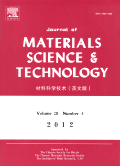
Journal of Materials Science & Technology
Transforming Ideas into Advanced Material SolutionsThe Journal of Materials Science & Technology, published by JOURNAL MATER SCI TECHNOL in China, is a leading forum for the latest research in the multidisciplinary field of materials science. With the ISSN 1005-0302 and E-ISSN 1941-1162, this esteemed journal boasts an impressive impact factor and has established itself as a vital resource for professionals, researchers, and students alike. Covering a wide range of topics, including ceramics, composites, materials chemistry, mechanical engineering, and polymers, it has achieved a coveted Q1 ranking in multiple categories as of 2023, reflecting its position in the top tier of scholarly publications. Notably, the journal excels in its Scopus ranks, placing within the top 5% in categories such as Metals and Alloys and Mechanical Engineering. Aiming to foster knowledge and innovation in material development and application, the journal is committed to facilitating groundbreaking research and collaborations that propel the field forward. With its convergence of insights from 1993 to 2025, the Journal of Materials Science & Technology remains an indispensable resource for the advancement of materials science.
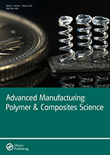
Advanced Manufacturing-Polymer & Composites Science
Pioneering Innovations in Polymer and Composite MaterialsAdvanced Manufacturing-Polymer & Composites Science, published by Taylor & Francis Ltd, is a prominent open-access journal dedicated to the cutting-edge fields of polymer and composite materials in advanced manufacturing. With an ISSN of 2055-0340 and an E-ISSN of 2055-0359, this journal has been providing researchers, professionals, and students critical insights since its inception in 2015. The journal is characterized by its pivotal role in disseminating high-quality research that intersects with crucial areas such as Electrical and Electronic Engineering, Management of Technology and Innovation, and Polymers and Plastics, as indicated by its Q3 and Q2 rankings across these categories in 2023. In addition, it has established a significant presence in Scopus rankings, reflecting its contribution to the academic community with specific ranks in the top half of its fields. Recognizing the importance of open access, the journal fosters wider dissemination of knowledge, allowing global access to groundbreaking studies that influence both research and practical applications. Operating from the United Kingdom, Advanced Manufacturing-Polymer & Composites Science continues to pave the way for innovation and collaboration in the field, making it an essential resource for anyone involved in materials science and engineering.

ADVANCED MATERIALS & PROCESSES
Navigating the Frontiers of Advanced Materials ResearchADVANCED MATERIALS & PROCESSES is a vital resource for professionals and researchers in the fields of Materials Science, Mechanical Engineering, and Mechanics of Materials, published by ASM International, a renowned leader in material science publishing. Since its inception in 1985, this journal has aimed to disseminate cutting-edge research and innovative developments in advanced materials usage and processing techniques, contributing to the advancement of engineering applications. Despite its current Q4 quartile ranking in its respective categories, the journal endeavors to elevate the discourse within the field by providing a platform for high-quality articles, reviews, and case studies. Subscribers can benefit from insights into the latest trends and technologies that shape the materials landscape, although the journal is not open access. With its broad coverage and commitment to supporting the academic and professional community, ADVANCED MATERIALS & PROCESSES remains an essential publication for anyone invested in the future of materials innovation.

Materiali in Tehnologije
Pioneering Research in Metals and PlasticsMateriali in Tehnologije is a distinguished peer-reviewed journal dedicated to the field of materials science, focusing specifically on metals and polymers. Published by the Institute for Metals and Materials Technology in Slovenia, this open-access journal has been at the forefront of disseminating research findings and innovative technologies since 2000. With a current impact factor that reflects its increasing visibility in the academic community, Materiali in Tehnologije serves as an invaluable resource for researchers, professionals, and students alike, encompassing a wide array of studies in the categories of Metals and Alloys, as well as Polymers and Plastics. The journal is indexed in Scopus, highlighting its relevance and contribution to the field, particularly with its ranks of Q3 in Metals and Alloys and Q4 in Polymers and Plastics. As it converges towards 2024, Materiali in Tehnologije continues to be a pivotal platform for knowledge exchange, encouraging advancements in materials research and technology.
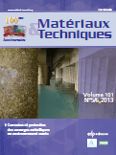
Materiaux & Techniques
Fostering Excellence in Material Science DiscourseMateriaux & Techniques, published by EDP SCIENCES S A, is a prominent journal in the field of materials science, specifically focusing on diverse and innovative techniques in material development and application. With an ISSN of 0032-6895 and an E-ISSN of 1778-3771, this French journal serves as a key resource for researchers and professionals looking to advance their knowledge and share their findings within the community. The journal holds a Q3 ranking in Materials Science (miscellaneous), indicating its role in contributing to various facets of material science research amidst a growing field. Despite operating under a traditional access model, it provides a platform for rigorous peer-reviewed studies and significant advancements in material technology. With a publication history tracing back to the late 1970s and extending through to 2024, Materiaux & Techniques continues to uphold its commitment to fostering high-quality discourse and innovation in materials science.
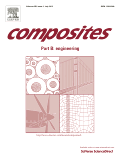
COMPOSITES PART B-ENGINEERING
Exploring New Frontiers in Composites and CeramicsCOMPOSITES PART B-ENGINEERING, published by Elsevier Science Ltd, stands at the forefront of research in the fields of engineering and materials science, specifically targeting the domains of composites, ceramics, and mechanical engineering. With an impressive impact factor and categorized in the prestigious Q1 quartiles across multiple categories including Industrial and Manufacturing Engineering and Mechanics of Materials, this journal fosters innovative research that significantly contributes to the advancement of composite materials and their applications. The journal has been diligently publishing high-quality peer-reviewed articles since its inception in 1996, and it continues to attract top-tier contributors and researchers who are dedicated to exploring emergent technologies and methodologies. Researchers, professionals, and students will find valuable insights and an extensive pool of resources in this essential journal, available through Open Access options that enhance its visibility and reach, allowing the dissemination of crucial knowledge to the global scientific community.
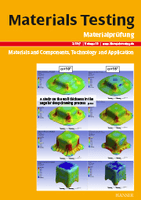
Materials Testing
Unveiling Insights in Mechanical EngineeringMaterials Testing is a renowned journal published by Walter de Gruyter GmbH, serving the global scientific community in the fields of Materials Science, Mechanical Engineering, and Mechanics of Materials. With an ISSN of 0025-5300 and an E-ISSN of 2195-8572, this journal has been a significant contributor to the discourse on material performance, testing methodologies, and engineering innovations since its inception. The journal is recognized for its rigorous peer-review process and holds a commendable Q2 quartile ranking in multiple categories for 2023, showcasing its impact and relevance in the field. With open access options available, Materials Testing aims to disseminate valuable research findings and practical insights that drive advancements in technology and materials applications. By addressing the latest challenges and developments within the field, this publication serves as an essential resource for researchers, professionals, and students alike, fostering a deeper understanding of material properties and testing techniques.

Journal of Composites Science
Pioneering Research in Composites and CeramicsThe Journal of Composites Science, published by MDPI, is a premier Open Access journal dedicated to advancing the field of composites and materials science. Launched in 2017, this innovative journal provides a platform for researchers, professionals, and students to share findings, methodologies, and insights related to composites, ceramics, and engineering applications. With an impressive Q2 ranking in both the Ceramics and Composites and Engineering (miscellaneous) categories for 2023, the journal is well-positioned within the academic community, ranking 48th out of 204 in miscellaneous engineering and 47th out of 127 in ceramics and composites according to Scopus. The journal's open-access model ensures that high-quality research is widely available to the scientific community, fostering collaboration and innovation. Situated in defensive Switzerland at ST ALBAN-ANLAGE 66, CH-4052 BASEL, the Journal of Composites Science is an essential resource for those seeking to stay at the forefront of the composites domain and drive progress in engineering practices.
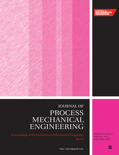
PROCEEDINGS OF THE INSTITUTION OF MECHANICAL ENGINEERS PART E-JOURNAL OF PROCESS MECHANICAL ENGINEERING
Unveiling Insights for Tomorrow’s Mechanical ChallengesPROCEEDINGS OF THE INSTITUTION OF MECHANICAL ENGINEERS PART E - JOURNAL OF PROCESS MECHANICAL ENGINEERING is a leading peer-reviewed journal published by SAGE Publications Ltd, dedicated to the field of mechanical and process engineering. With a strong emphasis on the latest research and developments, this journal covers a wide range of topics that are vital for advancing the understanding and application of mechanical processes in engineering. Holding an impressive Q2 ranking in both Industrial and Manufacturing Engineering and Mechanical Engineering categories for 2023, it promotes high-quality scholarly articles that are instrumental for researchers and professionals alike. The journal's historical range from 1989 to 2024 showcases its commitment to consistently delivering vital insights to the engineering community, making it an essential resource for those seeking to stay at the forefront of the discipline. Although it does not currently offer open access options, the impact factor and relevance of the journal ensure that it remains a valuable platform for disseminating significant findings in the field.
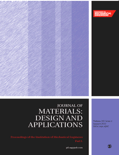
PROCEEDINGS OF THE INSTITUTION OF MECHANICAL ENGINEERS PART L-JOURNAL OF MATERIALS-DESIGN AND APPLICATIONS
Fostering Collaboration in Mechanical Engineering and Materials SciencePROCEEDINGS OF THE INSTITUTION OF MECHANICAL ENGINEERS PART L-JOURNAL OF MATERIALS-DESIGN AND APPLICATIONS is a prestigious academic journal published by SAGE PUBLICATIONS LTD, focusing on the dynamic fields of mechanical engineering and materials science. With an impressive impact factor reflective of its rigorous scholarly contributions, this journal serves as a vital platform for the dissemination of innovative research and practical applications in materials design and engineering processes. Since its inception in 1999 and continuing through 2024, it has maintained a robust reputation, achieving a Q2 ranking in both Materials Science (miscellaneous) and Mechanical Engineering categories, as well as commendable Scopus ranks that place it in the top percentiles of its fields. Located in the United Kingdom, the journal encourages submissions from researchers and professionals who are seeking to advance their understanding of materials applications while fostering interdisciplinary collaboration. Although it currently operates under traditional access terms, the journal prioritizes impactful research that addresses contemporary challenges in design and manufacturing, ensuring that it remains a must-read for anyone invested in the innovations shaping our technological landscape.